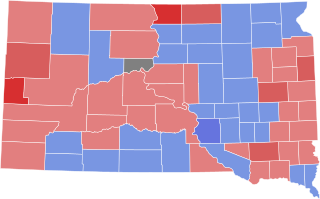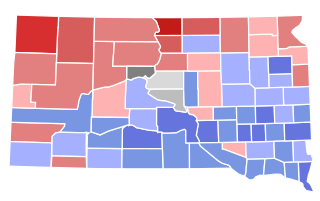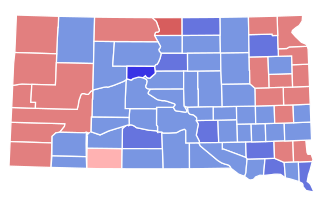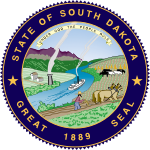
William John Bulow was an American politician and lawyer. He was the first Democratic Governor of South Dakota, serving from 1927 to 1931. He received the highest number of votes of any Democratic candidate for governor in the state up to that time. Bulow then went on to serve as a member of the United States Senate from South Dakota from 1931 to 1943.

William Henry McMaster was an American politician who served as the tenth Governor of South Dakota from 1921 until 1925. A member of the Republican Party, he went on to serve as a member of the United States Senate from South Dakota from 1925 to 1931.

The 1904 South Dakota gubernatorial election was held on November 8, 1904. Incumbent Republican Governor Charles N. Herreid declined to run for re-election to a third term. Clark County State's Attorney Samuel H. Elrod won the Republican nomination to run as Herreid's successor, and he faced Democratic nominee Louis N. Crill, the former President of the State Senate, and former U.S. Congressman Freeman Knowles, the Socialist nominee. For the first time since 1894, the Democratic and Populist Parties nominated separate candidates. Ultimately, the split in the two parties did not prove dispositive; Elrod defeated Crill and the other candidates in a landslide.

The 1920 United States Senate election in South Dakota took place on November 2, 1920. Incumbent Democratic Senator Edwin S. Johnson declined to seek re-election to a second term. In the Democratic primary, attorney Ulysses Simpson Grant Cherry defeated former State Senator Louis Napoleon Crill and former U.S. Marshal Tom Taubman, while in the Republican primary, Governor Peter Norbeck defeated former State Supreme Court Justice Dick Haney. In the general election, Cherry and Norbeck faced a litany of independent candidates, including Nonpartisan League candidate Tom Ayres. Benefiting from the split in left-wing candidates, Norbeck won by a wide margin, with Ayres narrowly beating out Cherry for second place.

The 1942 United States Senate election in South Dakota took place on November 3, 1942. Incumbent Democratic Senator William J. Bulow ran for re-election to a third term. During the primary, Bulow was attacked for being insufficiently supportive of President Franklin Roosevelt's foreign policy and war preparedness. Former Governor Tom Berry, Bulow's chief opponent, drew a contrast between Bulow's isolationism and his support for Roosevelt's policies. In the end, Berry defeated Bulow in a landslide, and advanced to the general election, where he faced Harlan J. Bushfield, the incumbent Republican Governor of South Dakota. As Republicans gained ground nationwide, Bushfield defeated Berry in a landslide to pick up the seat for the Republican Party. Bushfield did not serve his full term, however; shortly before the 1948 U.S. Senate election, he died.

The 1918 United States Senate election in South Dakota took place on November 5, 1918. Incumbent Republican Senator Thomas Sterling sought re-election in his first popular election. He defeated former Governor Frank M. Byrne in the Republican primary and then faced former State Representative Orville Rinehart, the 1916 Democratic nominee for Governor, in the general election. Sterling defeated Rinehart, along with independent candidate W. T. Rafferty, by a wide margin to win re-election.

The 1924 United States Senate election in South Dakota took place on November 4, 1924. Incumbent Senator Thomas Sterling ran for re-election to a third term, but he was defeated in the Republican primary by Governor William H. McMaster. In the general election, McMaster was opposed by attorney Ulysses Simpson Grant Cherry, the Democratic nominee, and several independent candidates. McMaster defeated his opponents by a wide margin, but fell far short of a majority, winning only 44% of the vote.

The 1920 United States Senate election in South Dakota took place on November 2, 1926. Incumbent Republican Senator Peter Norbeck ran for re-election to a second term. In the Republican primary, he faced former State Senator George J. Danforth, who had the support of Governor Carl Gunderson in an intra-party split between Norbeck and Gunderson. Norbeck defeated Danforth by a wide margin, and then faced former State Representative Charles J. Gunderson in the general election. Norbeck defeated Gunderson in a landslide to win re-election.

The 1932 United States Senate election in South Dakota took place on November 7, 1944. Incumbent Republican Senator Chan Gurney ran for re-election to a second term. He faced a strong challenge in the Republican primary from Lieutenant Governor A. C. Miller, who claimed that Gurney was too friendly to New Deal policies, but was defeated by Gurney by a wide margin. In the general election, Gurney faced former State Senator George M. Bradshaw, whom he defeated in a landslide as Thomas E. Dewey was decisively winning the state over President Franklin D. Roosevelt in the presidential election.

The 1962 United States Senate election in South Dakota took place on November 6, 1962. Incumbent Republican Senator Francis H. Case ran for re-election to a third term. He won the Republican primary against Attorney General A. C. Miller, but shortly after the primary, died. The Republican State Central Committee named Lieutenant Governor Joseph H. Bottum as Case's replacement on the ballot, and Governor Archie Gubbrud appointed Bottum to fill the vacancy caused by Case's death. In the general election, Bottum was opposed by Democratic nominee George McGovern, the Director of Food for Peace and the former U.S. Congressman from South Dakota's 1st congressional district. The contest between Bottum and McGovern was quite close, with McGovern narrowly defeating him for re-election by just 597 votes, making him the first Democrat to win a Senate election in South Dakota since William J. Bulow's win in 1936.

The 1968 United States Senate election in South Dakota took place on November 5, 1968. Incumbent Democratic Senator George McGovern ran for re-election to a second term. He was challenged by former Governor Archie M. Gubbrud, who was persuaded to enter the race by the South Dakota Republican establishment. McGovern defeated Gubbrud by a wide margin, even as Richard Nixon was defeating Hubert Humphrey in the state's presidential election in a landslide.

The 1938 United States Senate elections in South Dakota took place on November 8, 1938. Incumbent Republican Senator Peter Norbeck died in office on December 20, 1936. Herbert E. Hitchcock was appointed by Governor Tom Berry as Norbeck's replacement. Two elections for the same Senate seat were held on the same day; one as a special election to fill the remainder of Norbeck's six-year term, and another to select a Senator to serve the next six-year term.

The 1924 South Dakota gubernatorial election was held on November 4, 1924. Incumbent Republican Governor William H. McMaster declined to run for re-election to a third term, instead opting to run for the U.S. Senate. Lieutenant Governor Carl Gunderson won the Republican primary unopposed. In the general election, he faced three prominent opponents: Democratic nominee William J. Bulow, a former State Senator and Mayor of Beresford; Farmer–Labor nominee A. L. Putnam; and perennial candidate Richard O. Richards. Gunderson. With the left-leaning vote split, Gunderson won the election in a landslide.

The 1926 South Dakota gubernatorial election was held on November 2, 1926. Incumbent Republican Governor Carl Gunderson ran for re-election to a second term. The election was largely a rematch of the 1924 election, with Gunderson's chief opponent from two years prior, Democrat William J. Bulow, challenging him once again. Two other candidates—Farmer–Labor nominee Tom Ayres and Pierre Mayor John E. Hipple, an independent—also ran. Though the left-leaning vote was split, Bulow was still able to win a decisive victory over Gunderson, whose support from two years earlier had completely collapsed.

The 1928 South Dakota gubernatorial election was held on November 6, 1928. Incumbent Democratic Governor William J. Bulow ran for re-election to a second term. In the general election, he faced Attorney General Buell F. Jones, the Republican nominee. Despite Republican presidential nominee Herbert Hoover overwhelmingly defeating Democratic nominee Al Smith overwhelmingly in South Dakota, Bulow defeated Jones by a decisive margin to retain the governorship. In so doing, he became the first Democratic candidate for Governor to receive a majority of the vote in the state's history.

The 1930 South Dakota gubernatorial election was held on November 4, 1930. Incumbent Democratic Governor William J. Bulow declined to run for re-election to a third term, instead opting to successfully run for the U.S. Senate. The Republican nomination was hard-fought and the primary was crowded; because no candidate received 35% of the vote, state law required that the nomination be decided at a state party convention. There, former State Senator Warren Green, the last-place finisher in the primary, defeated Secretary of State Gladys Pyle, the plurality winner. In the general election, Green faced D. A. McCullough, the state's Rural Credits Commissioner and the Democratic nominee. Despite Bulow's success in the preceding two elections, Green defeated McCullough by a decisive margin—even as Bulow himself was elected to the U.S. Senate.

The 1932 South Dakota gubernatorial election was held on November 8, 1932. Incumbent Republican Governor Warren Green ran for re-election to a second term. He defeated former Governor Carl Gunderson in the Republican primary and faced former State Representative Tom Berry, the Democratic nominee, in the general election. Aided by Democratic presidential nominee Franklin D. Roosevelt's landslide victory in South Dakota, Berry defeated Green for re-election in a landslide.

The 1936 South Dakota gubernatorial election was held on November 3, 1936. Incumbent Democratic Governor Tom Berry ran for re-election to a third term, the first Governor of South Dakota to do so. Berry was challenged by Republican Leslie Jensen, the former Collector of Internal Revenue for the state of South Dakota. Both Berry and Jensen won their primaries uncontested and advanced to the general election. Some drama surrounded the potential candidacy of Democratic State Auditor George O'Neill as an independent candidate for Governor or, in the alternative, his cross-party endorsement of Jensen; after initially announcing his campaign and hedging, O'Neill dropped out of the race in September and endorsed the Democratic ticket in the state, including Berry.

The 1938 South Dakota gubernatorial election was held on November 8, 1938. Incumbent Republican Governor Leslie Jensen declined to seek re-election and instead unsuccessfully ran for the U.S. Senate. Harlan J. Bushfield, the former Chairman of the South Dakota Republican Party, won the Republican primary to succeed Jensen. In the general election, he faced Democratic nominee Oscar Fosheim, a State Representative from Miner County, in the general election. Bushfield defeated Fosheim by a relatively close margin, winning his first term as governor.

The 1940 South Dakota gubernatorial election was held on November 5, 1940. Incumbent Republican Governor Harlan J. Bushfield sought re-election to a second term. After winning the Republican primary by a large margin, he faced Democrat Lewis W. Bicknell, former Day County State's Attorney, in the general election. Though Bushfield underperformed Republican presidential nominee Wendell Willkie, who won the state in a landslide, he nonetheless defeated Bicknell by a wide margin to easily win re-election.




















